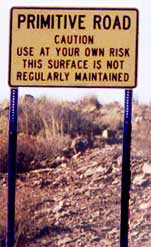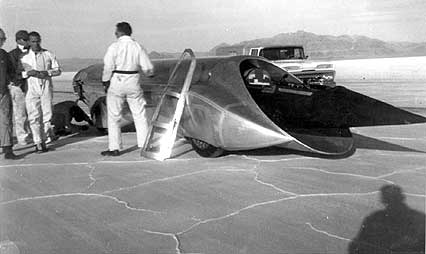 |
 |
WHEN
EVERYTHING WAS PERMITTED, PT. 2
A LINEAR HISTORY OF MAXIMUM HORSEPOWER IN A FORGOTTEN
AGE OF NO LIMITS
|
By Cole Coonce
Photo courtesy Cole Coonce
11/8/05
 hh,
the 1960s. This is where the LSR gets truly over-the-top.
The assault on the 400 mph barrier began via the intrusion
of some wily Americans who sullied what had heretofore had
been the sanctified sandbox of European aristocracy. After
the shootout between Eyston and Cobb concluded, the Yanks
began kicking up dust storms on the salt flats in contraptions
so stripped down, coarse, and primitive that the Brits kinda'
viewed them as uncouth tinderbox folk art. hh,
the 1960s. This is where the LSR gets truly over-the-top.
The assault on the 400 mph barrier began via the intrusion
of some wily Americans who sullied what had heretofore had
been the sanctified sandbox of European aristocracy. After
the shootout between Eyston and Cobb concluded, the Yanks
began kicking up dust storms on the salt flats in contraptions
so stripped down, coarse, and primitive that the Brits kinda'
viewed them as uncouth tinderbox folk art.
Perhaps most emblematic of this mindset was Akron, Ohio,
scrapyard scavenger Art Arfons, a drag racer who terrorized
the strips with Allison aircraft engines until the National
Hot Rod Association pulls the rug on both his ingenuity and
his aircraft engines, and tried to relegate Arfons to a circus
act. In retaliation, Arfons doesn't get mad, he just turns
up the boost on a mighty mastodon of mutant machinery that
he has christened the "Cyclops," and aims his crosshairs
on the salt flats, leaving the drag strips in the rear view
mirror of his memory. "I had an Allison (aircraft engine)
for ten years and I couldn't get to 200 in the quarter mile,"
Arfons recalls about the '60s. "I wanted more horsepower."
It is difficult to ascertain what was the bigger monster at
this point: the racecar or Arfons himself.
To satisfy his jones for unbridled adrenaline, Arfons scores
an experimental J79 from a F-104 for $625. "I got it
when it was still classified," he said. "It had
been scrapped because of foreign object damage. I had hit
all the scrap yards and said, 'If you ever get a '79, I want
it.' So a guy called from Miami and he said, 'I got one.'

Arfons then called General Electric and asked for an owner's
manual, in essence sending a smoke signal to a GE whistleblower.
With something rotten in the Rubber City, a colonel from the
military paid Arfons a visit. "He said, 'That's a classified
engine, you're not allowed to have it,'" Arfons remembers.
"And I said, 'Well, here's my piece of paper (receipt).
I bought it after you threw it away.' I said, 'You can't have
it.' Two years later, they declassified it."
Arfons chained his military surplus monstrosity to a tree
in his back yard and--to the horror of his neighbors--began
purging the afternburners, searching for harmonic imbalances.
"There was a special wrench to take them apart,"
he said, referring to a ratchet that wasn't in his toolbox.
"I knew a man who worked at Wright Patterson (AFB) and
he got me the tool I needed to fix it. He would sign it out
and drop it by the fence for me. He'd check it out in the
morning and I'd get it back before he had to turn it in that
evening. I had to do that to take it apart and I had to do
that to put it together. The blades were all damaged, so I
just removed every third one. Never did balance the thing.
I just put it back together that way and it ran fine. It had
all the power I needed."
"He was armed with the biggest gun in town once he got
that J79," Craig Breedlove said, laughing with envy.
A SoCal drag racer and firefighter, Breedlove was just as
smitten with the concept of thrust unlimited as his compatriot
from Ohio. Indeed, cheap, abundant jet power enabled both
Arfons and Breedlove to dominate the Land Speed Record scene
throughout the decade.
|
